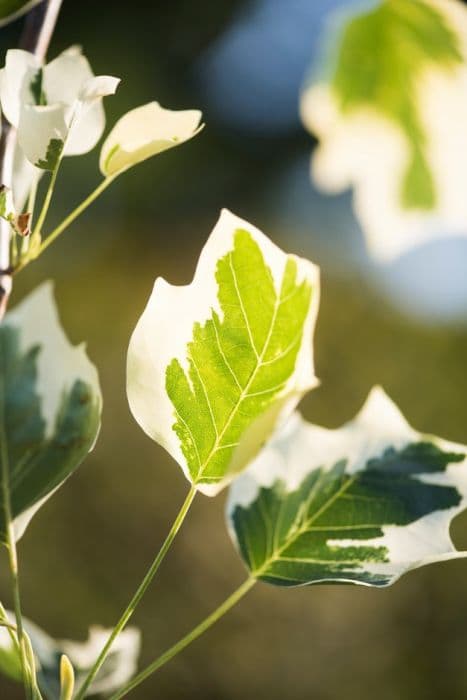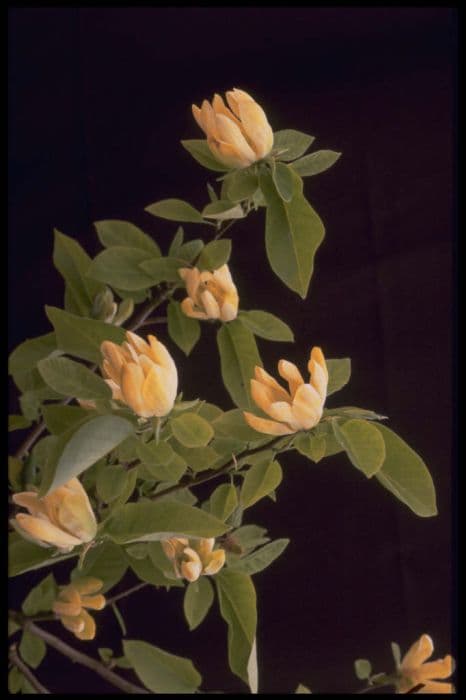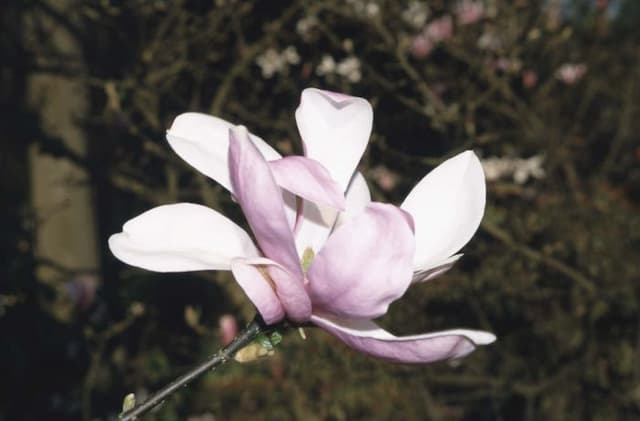Tulip Tree Liriodendron tulipifera 'Aureomarginatum' (v)

ABOUT
The plant in question, commonly known as the variegated tulip tree, boasts distinctive leaves that set it apart from other trees. The foliage is characterized by its unique shape, reminiscent of tulip flowers, with four lobes and a notch at the tip. What makes the 'Aureomarginatum' variety particularly striking is the creamy yellow to golden yellow edging that outlines each leaf, providing a beautiful contrast against the green center. These variegated leaves catch the light and create a luminous effect that can brighten up any landscape. When in bloom, the tree displays attractive flowers that share a resemblance with actual tulips in shape and color. The blossoms are greenish-yellow with a touch of orange on the inside. The variegated tulip tree's overall appearance is one of elegance and beauty, with its contrasting leaf colors and unique flower shape contributing to its ornamental appeal.
About this plant
 Names
NamesFamily
Magnoliaceae.
Synonyms
Tulip Tree, Tuliptree, Yellow Poplar, Tulip Poplar, Whitewood.
Common names
Liriodendron tulipifera var. aureomarginatum, Liriodendron tulipifera 'Aureomarginata'.
 Toxicity
ToxicityTo humans
The Tulip Tree, the most common name for Liriodendron tulipifera 'Aureomarginatum', is generally not considered toxic to humans. Ingesting parts of the Tulip Tree does not typically result in poisoning or severe adverse effects; thus, no specific symptoms of poisoning are associated with this plant.
To pets
The Tulip Tree, the most common name for Liriodendron tulipifera 'Aureomarginatum', is also not commonly toxic to pets. There are no well-documented cases of pet poisoning from ingestion of parts of the Tulip Tree, and it is not listed among plants that are known to be poisonous to household pets such as dogs and cats. Therefore, ingestion is unlikely to cause serious health problems or symptoms of poisoning in pets.
 Characteristics
CharacteristicsLife cycle
Perennials
Foliage type
Deciduous
Color of leaves
Variegated
Flower color
Greenish-yellow
Height
70 80 feet (21.3 24.4 meters)
Spread
35 40 feet (10.7 12.2 meters)
Plant type
Tree
Hardiness zones
5
Native area
North America
Benefits
 General Benefits
General Benefits- Aesthetic Appeal: The Liriodendron tulipifera 'Aureomarginatum', commonly referred to as the Tulip Tree, has distinctive variegated foliage and attractive tulip-like flowers that enhance the visual appeal of any landscape.
- Shade Provider: With its broad canopy, the Tulip Tree offers ample shade in gardens and parks, creating cooler areas during hot summer months.
- Habitat for Wildlife: The tree serves as a habitat and food source for various species, including birds and beneficial insects.
- Seasonal Interest: It provides year-round interest through its summer flowers, autumn leaf color, and winter silhouette.
- Erosion Control: The extensive root system of the Tulip Tree helps stabilize soil and prevent erosion, particularly on slopes.
- Wood Production: The tree is valued for its strong, lightweight wood which is used in furniture, veneer, and other woodcrafts.
- Carbon Sequestration: As a fast-growing tree, the Tulip Tree is effective in capturing carbon dioxide from the atmosphere, helping mitigate the effects of climate change.
- Enhancing Biodiversity: By planting the Tulip Tree, gardeners and landscapers can increase plant diversity in an area, supporting broader ecological balance.
- Recreational Uses: The tree's majestic size and beauty make it a favorite in parks and recreational areas for picnicking, photography, and educational purposes.
 Medical Properties
Medical PropertiesThis plant is not used for medical purposes.
 Air-purifying Qualities
Air-purifying QualitiesThis plant is not specifically known for air purifying qualities.
 Other Uses
Other Uses- Woodworking: The wood of the Tulip Tree is valued for its workability and grain, making it a favorite for furniture, cabinetry, and veneer applications.
- Canoe Making: Indigenous peoples have historically used the trunks of large Tulip Trees to create dugout canoes due to their size and the wood's resistance to splitting.
- Honey Production: While not directly producing honey, Tulip Trees provide a source of nectar for honeybees, which can produce a unique type of honey from it.
- Wildlife Habitat: The tree offers shelter and food for various bird species, including orioles and squirrels, which eat the seeds.
- Photography Backdrop: With its distinct flowers and beautifully variegated leaves, the Tulip Tree 'Aureomarginatum' serves as an excellent subject or backdrop for nature photographers.
- Ink and Dye: Historically, the bark and leaves may have been used to create plant-based inks and dyes for fabric and art.
- Landscape Architecture: Due to its appealing, variegated foliage and shape, the tree is often used in landscape designs for large spaces and parks.
- Windbreaks and Privacy Screens: When planted in rows, these trees can provide wind protection and privacy for properties.
- Education and Research: Botanists and horticulturalists study the Tulip Tree for its unique characteristics, contributing to educational programs about arboreal diversity.
- Craft Material: Leaves and dried flowers can be used in crafts, such as pressed flower art or for creating natural decorative elements.
Interesting Facts
 Feng Shui
Feng ShuiThe Tulip Tree is not used in Feng Shui practice.
 Zodiac Sign Compitability
Zodiac Sign CompitabilityThe Tulip Tree is not used in astrology practice.
 Plant Symbolism
Plant Symbolism- Beauty and Grace: The 'Aureomarginatum' variation of the Tulip Tree, with its striking variegated foliage, symbolizes beauty and grace, reflecting how its appearance adds elegance to any landscape.
- Majestic Presence: The Tulip Tree, being one of the tallest of the eastern North American deciduous trees, represents majestic presence and can denote strength and prominence.
- Healing: Historically, the Tulip Tree has been used for medicinal purposes, symbolizing healing and health.
- Abundance: As a fast-growing tree that often produces a lot of flowers, it can also symbolize abundance and fertility.
- American Heritage: Given its status as a native tree in eastern North America, the Tulip Tree is often associated with the symbolism of American heritage and tradition.
 Water
WaterThe Tulip Tree requires consistent moisture, especially during its growing season in spring and summer. It should be watered deeply once a week, providing about 1.5 to 2.5 gallons of water each time for younger trees. Mature trees can handle more occasional but thorough watering. During periods of drought or extreme heat, watering frequency should increase. In wet climates or during fall and winter, reduce watering to reflect natural precipitation and plant dormancy.
 Light
LightThe Tulip Tree thrives in full sun but can tolerate partial shade. The ideal location is an area where it can receive at least six hours of direct sunlight each day, away from buildings or other structures that might cast too much shade.
 Temperature
TemperatureThe Tulip Tree prefers moderate temperatures, thriving in zones 4 through 9. It can withstand a maximum temperature of around 90°F and can survive winter cold down to -20°F. Ideal growing temperatures are between 60°F and 70°F.
 Pruning
PruningPrune the Tulip Tree in late winter or early spring before new growth begins to remove any dead or diseased branches and to shape the tree. Young trees benefit from annual pruning to establish a strong structure. Mature trees may only require pruning every few years to maintain health and appearance.
 Cleaning
CleaningNot needed
 Soil
SoilThe Tulip Tree 'Aureomarginatum' thrives in well-draining, fertile soil with a pH between 6.0 to 7.5. A mix containing loamy soil with some sand and compost is beneficial. Mulch can help maintain soil moisture and temperature.
 Repotting
RepottingThe Tulip Tree 'Aureomarginatum' being a large tree, is not typically repotted. When young, repot every 2-3 years, but it's commonly planted outdoors due to its size.
 Humidity & Misting
Humidity & MistingThe Tulip Tree 'Aureomarginatum' prefers moderate humidity levels but is adaptable to the typical outdoor humidity where it thrives.
 Suitable locations
Suitable locationsIndoor
Not suitable for indoor growth due to size.
Outdoor
Plant in full sun, ensure moist, well-drained soil, and ample space.
Hardiness zone
4-9 USDA
 Life cycle
Life cycleThe variegated tulip tree (Liriodendron tulipifera 'Aureomarginatum') begins its life as a seed, which germinates in spring after stratification through a cold period. The seedling grows rapidly under the right conditions of fertile, moist soil and full sun to partial shade. After several years, it reaches the sapling stage, displaying its characteristic bright green leaves with creamy yellow margins. As it matures into a full-grown tree, it may ultimately reach heights of 70 to 90 feet. The variegated tulip tree will start flowering after 15-20 years, producing tulip-like flowers with greenish-yellow petals and an orange band at the base. After pollination, the tree develops cone-shaped fruit clusters that release samaras, winged seeds that are dispersed by the wind, completing the life cycle.
 Propogation
PropogationPropogation time
Spring-Early Summer
The tulip tree, specifically the Liriodendron tulipifera 'Aureomarginatum', is most commonly propagated through semi-hardwood cuttings. This is typically done in late summer when the current year's growth has started to mature but is not yet fully hardened. The selected branch for cutting should be healthy and approximately 6 to 8 inches (15 to 20 centimeters) long, with several leaves. The leaves on the lower half of the cutting are removed, and the cut end is dipped in a rooting hormone before being placed in a well-draining rooting medium such as a mixture of peat and perlite. The cutting should be kept in a humid environment with indirect light until roots have developed, which can take several weeks to a few months. Once the cutting has established a robust root system, it can be transplanted into a larger pot or directly into the garden.







![Magnolia [Black Tulip]](/_next/image?url=https%3A%2F%2Fplants-admin.emdemapps.com%2Fimages%2Fplants%2F%2Fimages%2F604b590290fc7.png&w=640&q=75)

